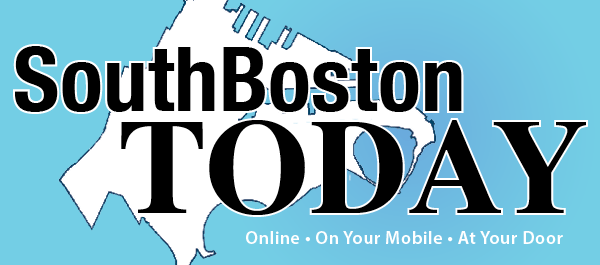By Brian R. Mahoney
Editor Emeritus, In Memoriam
(First Printed in 2011)
Third in a three part series
Our former editor and native son, the late Brian Mahoney, was all things South Boston – its history and its celebrations, especially the combined Saint Patrick’s and Evacuation Day. In his memory, we are pleased to re-print his popular historical series.
Experience has taught us in Boston that rain, sleet, snow, gale force winds and freezing temperatures that arrive sometimes in February and March are known as a “Nor’easter”. Unaccustomed, The British could only equate this phenomenon to as “Hurrycane”.
The British plan was to cross to Castle William (Castle Island), assemble, and then assault across at “Dorchester Point”. Instead General Howe later wrote a “Hurricane” had forced the cancellation of the assault ‘in the fear they would all be lost” due to the weather. The same storm that drove the British indoors was used by the Americans as a fortuitous opportunity to strengthen their defenses, so that when the storm abated by noon on March 6, the British realized their chance to assault had passed. Undeterred, a squadron of warships weighed anchor and with sails full attempted to close on the North Shore (First Street). The looming Heights of the “Bush Tree” Hill forced the British to attempt a dangerous maneuver.
Shifting nearly every cannon to one side of the ship, the British intended this would allow the few cannons remaining on the other side to gain enough elevation to strike the American position on “Bush Tree”. This rarely used tactic carried the danger of swamping or even capsizing the ship. The North Shore at the time was riddled with inlets, barely submerged mud flats, and deepwater channels. This unpredictability, plus the batteries at “Bush Tree” and “Dorchester Point”, made the danger of grounding a ship under American guns too great to allow the British ships’ cannons to continue firing and this action was halted.
At “Dorchester Point” the Americans were giddy at the British ships retreat. They began waving flags, gesturing, and generally taunting the British Troops at Castle William (Castle Island). The British at the castle had fired but found the range prohibitive. To counter this, the British attempted a double load of powder. Unfortunately this caused cannon to explode killing and wounding several British. That ended the day’s events and on March 7 an unspoken truce seemed to be in place and the British began making preparations to pack up.
On March 8 the intently watching Americans were dismayed to observe and receive reports that the British efforts toward withdrawing had turned into looting and destruction. It was then Washington played his final card. With sunset the Americans, who had kept their last 10 cannons behind the base of “Nook Hill” at “C” and 3rd Street, began the construction of the final and closest battery. Late into the night the American troops labored. Then, perhaps due to overconfidence, a soldier lit a fire for warmth.
Almost immediately the British “Green” Battery (at Washington and Berkeley Streets), alerted to their location, began a deadly fire. A company of the 10th Artillery Regiment under Captain Thomas Pierce continued to work under this withering fire. This unfinished position attempted to return fire. A 17-year-old Private, Stephen Jennings of Norton, dashed back and forth bringing powder to the cannons. It was during one of these runs he was felled by a bursting shell. Watching this was 25 yr old Sgt. Obadiah Adams from Littleton and 33 yr old Surgeon Enoch Dole from Lancaster. Along with two other soldiers, they grabbed a litter and ran to aid Jennings. Sadly, as all four gathered round his fallen form, yet another British shell exploded, killing all four of the rescue party. Ironically, the act of aiding and hovering over Jennings, by the four, shielded him and he survived with the loss of a hand and eye. The firing continued all night, ending at sunrise after over 800 cannon balls had been fired and the American abandoned the fortification attempts.
This action seems, at least initially, to have prompted the British to cease the town’s destruction and continue the evacuation. Still by the morning of the 14th Washington had tired of the British stalling tactics. He was well aware more troops had already sailed from England. In any event, Washington was spoiling for a fight. “If the enemy will be kind enough to come out for a fight, I mean to give them one” he stated. In full view and in broad daylight, the very place that the very first soldiers of this new army, of this new nation, under this new commanding General had given the “last full measure”, he ordered to be fortified.
By late afternoon on March 16th, this final and most ominous position was completed. The next day, March 17th, the last British ship cleared Boston Harbor by noon as American troops entered the city. These troops discovered the final contempt of the British who had looted and used churches and meeting houses cavalry stables. In fact, in violation of the cease fire, they set Castle William ablaze as they left. Washington, expecting English treachery, placed in command as Officer of the Day (O.D.) General John Sullivan of County Wexford and made the password “St. Patrick”. So in effect the great British Empire surrendered their first American Colony to an Irish Catholic. This would probably be comparable to a former plantation slave owner working and taking orders under former African slave. “Those that laugh last, laugh best.”
How did this action, without which, arguably, the revolution would have failed, become a footnote in history? Would the Revolution have survived without their secure base in Boston? The British successfully moved in and occupied New York, New Jersey and Philadelphia. Over the next year, the only other American victory was the Christmas raid at Trenton, so how did the victory at Boston become so overlooked?
When the British fleet sailed away that St. Patrick’s morning they left behind their hatred of the Irish and Catholics that remains with us in some form and by some people to this day. Consider that the battle occurred 236 years ago but for the first 130 years it was never observed. This is only the 108 observance. The ruling political elite were determined to keep the Irish in their place, but the joining of St. Patrick’s and Evacuation was seen by the Irish, as divine intervention.
That and the flood tide of Irish Immigration swelled their ranks to political power. Prior to that every undesirable activity was placed in South Boston by the ruling elite. The poor house and insane asylum were placed in South Boston. Except for the “Twin Hills”, all of our “Heights” were leveled to fill in the Back Bay. A 45-acre park created for South Boston residents was first re-claimed by the Government as a military base and is now site of the Convention Center.
When the Dorchester Heights Monument was dedicated in 1902 the guest speaker referred to the longstanding discrimination toward the Irish South Boston by noting “The Mayflower and the Shamrock have finally joined”. Even then St. Patrick could only be celebrated under the umbrella of Evacuation Day.
Yet, even today, a simple parade to honor the military birth of America and our cultural heritage is constantly under attack, nowhere else and no other parade is singled out to be the target of others’ political agenda. Not a single court in Massachusetts had the courage or honesty to give us the right that was so obvious the U. S. Supreme Court upheld it unanimously. 9-0!
I have a framed sign in my house. It was printed AFTER my mother was born. It reads “No Irish Need Apply”. As we watch officially sanctioned assaults on our parade and us continue, it’s obvious that some things haven’t changed all that much. Still, here we stand and will always stand. Celebrate with pride.
Happy Evacuation and St. Patrick’s Day.
Take care until next week.











